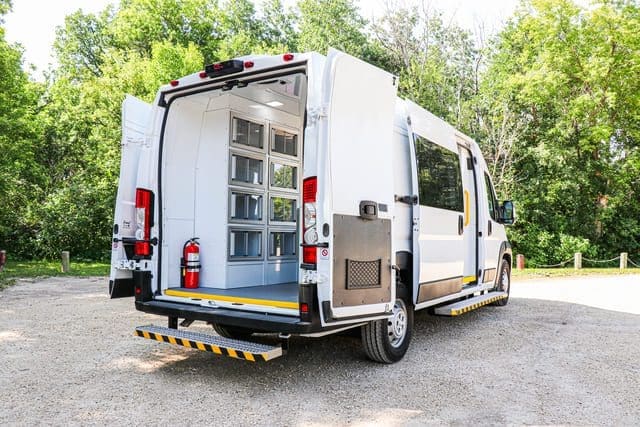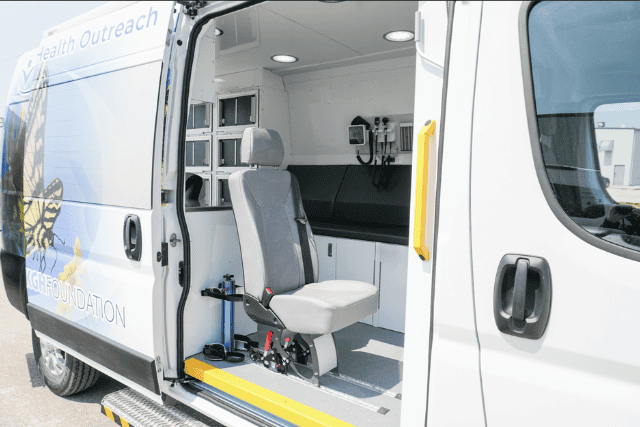Did you know almost 560,000 Americans need dialysis treatments? If you’re an organization wanting to provide this life-saving service, you might be feeling stuck. How can you set up a clinic that’s easy for patients to access? How can you make sure they get their treatments without all the hassle and travel? It’s a lot to think about, and it can feel overwhelming.
That’s where we come in. At AVAN Mobility, we’ve been helping organizations solve problems like these for over ten years. Our mission is to make healthcare and transportation accessible to every corner of the U.S. We build innovative vehicles that organizations like yours can use to bring medical care right to where it’s needed.
In this article, we’ll dive into what mobile dialysis is and how it works. By the time you finish reading, you’ll have a clear idea of how to provide dialysis treatments on the go, making life easier for your patients and your organization.
What is mobile dialysis?
Kidney disease affects 1 in 7 adults in America. In 2021 alone, over 135,000 Americans were newly diagnosed with kidney failure. With 37 million adults living with kidney disease, it’s the fastest-growing non-contagious disease in the country. The numbers are staggering, and the need for effective treatment is crucial.
Mobile dialysis is a treatment that does the work of kidneys when they fail. It removes waste, salt, and extra water to prevent them from building up in the body. It also keeps safe levels of certain chemicals in your blood, such as potassium, sodium, and bicarbonate, and helps control blood pressure.
There are two main types of dialysis:
- Hemodialysis: Uses a machine and a filter to remove waste and water from the blood.
- Peritoneal dialysis: Uses the lining of your abdomen to filter blood inside your body.
Why is dialysis important? Without it, waste products and fluids build up in the body, which can be life-threatening. Regular dialysis treatments help patients live healthier, more comfortable lives.
What are the benefits of mobile dialysis?
Mobile dialysis is an innovative healthcare approach that takes this essential treatment on the road. Imagine a state-of-the-art clinic on wheels, equipped with all the necessary medical equipment to provide dialysis treatments. Mobile dialysis units can travel across the U.S., bringing care directly to patients who need it.
Mobile dialysis offers many benefits that can greatly help patients across the U.S. Let’s break down why it’s so useful:
Accessibility
Reaching remote areas: The biggest benefit of mobile dialysis clinics is that they can travel to rural areas where regular dialysis centers are too far away. This means patients living in these places can still get their treatments without having to travel long distances.
Easier diet management: Patients often have to find special renal-friendly foods when traveling long distances for dialysis. Mobile dialysis reduces the need for long trips, making it easier to stick to their dietary needs without extra hassle.
Convenience
Flexible schedules: Mobile dialysis units can adjust to fit patients’ schedules. This means treatments can happen at times that are most convenient for them, like early mornings or late evenings.
Closer to home: Having dialysis closer to home makes it easier for patients to get the care they need without the stress of a long trip. This is especially helpful for older adults or those with difficulty moving around. Imagine being in your 90s with mobility issues and having to drive 5 hours each way to a hospital a few times a week for dialysis treatment.
Improved quality of life
Less stress and fatigue: Some patients need dialysis three times a week, and each session can last up to four hours. Mobile dialysis reduces the need for long clinic trips, reducing stress and fatigue from frequent travel and long sessions.
More personal time: With less time spent traveling, patients have more time to spend with their families or do things they enjoy. For example, they might have time to exercise, read a book, or attend a family event.
Cost-effectiveness
Saving on travel costs: Regular trips to dialysis centers can be expensive. Mobile dialysis helps patients save money on transportation.
Fewer hospital visits: Dialysis can cost up to $90,000 a year, depending on the type of insurance you have for in-center dialysis treatments. Mobile dialysis can lower these costs by reducing the need for hospital visits and transportation.
Community impact
Supporting local healthcare: Mobile dialysis units help local healthcare by providing special care that isn’t available nearby. This makes the whole community healthier and free up more resources for traditional hospitals.
Raising awareness: When mobile dialysis clinics come to a community, they also spread awareness about kidney disease. They teach people why regular treatments are important and encourage early diagnosis and care.
Example: A mobile dialysis clinic parked at a local community center provides treatments and educates people about kidney health, making the whole community more informed.
Next, we’ll look at how mobile dialysis works and what’s needed to run a mobile dialysis clinic.
How you can use the Mobile Clinic Van for mobile dialysis

Using a Mobile Clinic Van for mobile dialysis is a great way to help patients wherever they are.
A mobile dialysis machine can be put directly in your Mobile Clinic Van, turning it into a mobile dialysis clinic. This allows you to bring dialysis treatments to patients, no matter where they live.
Features of the Mobile Clinic Van
“Doctor’s office on wheels” setup: The van looks and works like a basic doctor’s office. This makes patients feel comfortable and well taken care of, just like in a regular clinic.

Floor-to-ceiling cabinetry: There is lots of storage space for all the medical supplies and equipment. This keeps everything organized and easy to reach during dialysis sessions.
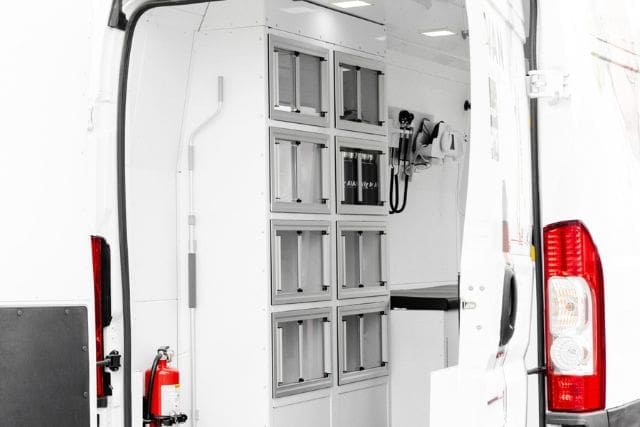
Patient bed with under-bed storage: The bed is comfortable for patients during treatments, which can last 3-4 hours. The storage under the bed is useful for keeping extra supplies close by.

Options for sink and fridge: A sink makes it easy to clean equipment. A fridge can store medications and special renal-friendly foods needed for dialysis patients.
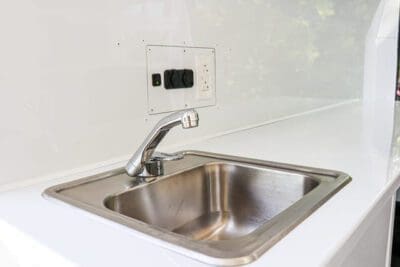

Power supply: The van has a strong power supply to keep the mobile dialysis machine running smoothly without any interruptions.

Rear heat & air conditioning: The van has heating and air conditioning to keep everyone comfortable, no matter the weather outside.
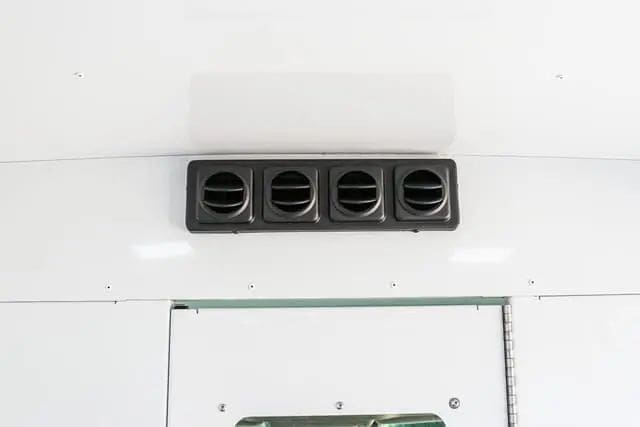
Clean, comfortable environment: The van is clean and cozy, making patients feel at ease during their treatments.
Using a Mobile Clinic Van for mobile dialysis means patients get the care they need without having to travel far or worry about the logistics side of things. It’s an easy, efficient, and caring way to deliver mobile dialysis treatments directly to the people who need them.
Want to learn more about mobile dialysis clinics?
You came to this article to understand mobile dialysis and its benefits for patients. After reading, you now know how it works, the benefits it offers, and how a Mobile Clinic Van can make it all possible.
At AVAN Mobility, we’ve dedicated the past 10+ years to manufacturing solutions that break down barriers to healthcare. No one should have to skip dialysis treatments just because they don’t live near a medical facility. Healthcare should be accessible, comfortable, and everyone for everyone.
If you have any other questions about mobile dialysis or how it works in the Mobile Clinic Van, click the button at the end of this article to speak to an expert.
If you’re not at the stage where you feel comfortable talking to someone about this yet, we have a couple of other resources you may be interested in. Start by checking out our article on how mobile clinics are improving the healthcare industry.
After that, take a look at our guide on securing grants for mobile health clinics. This should give some focus in the right direction in terms of funding.


